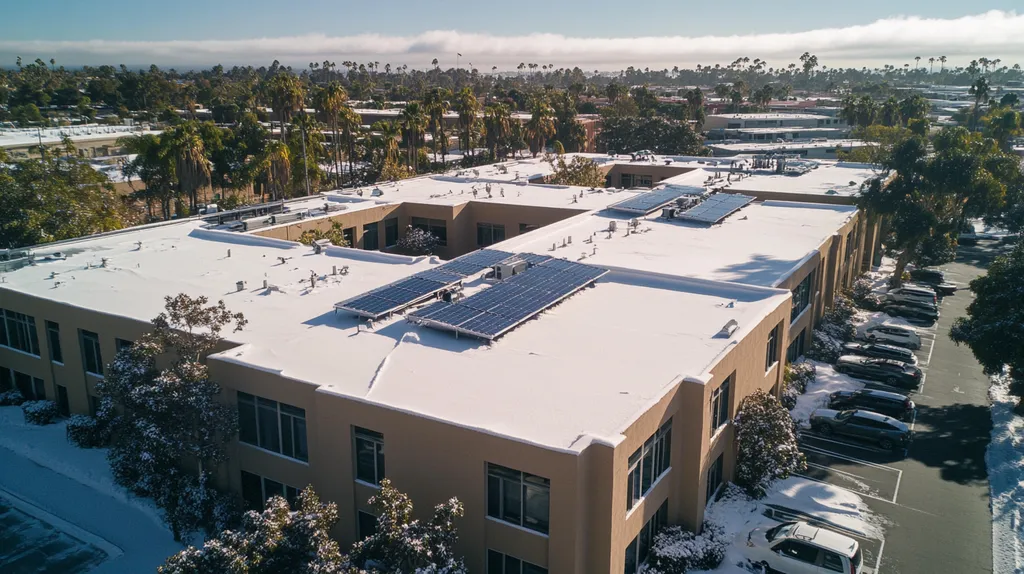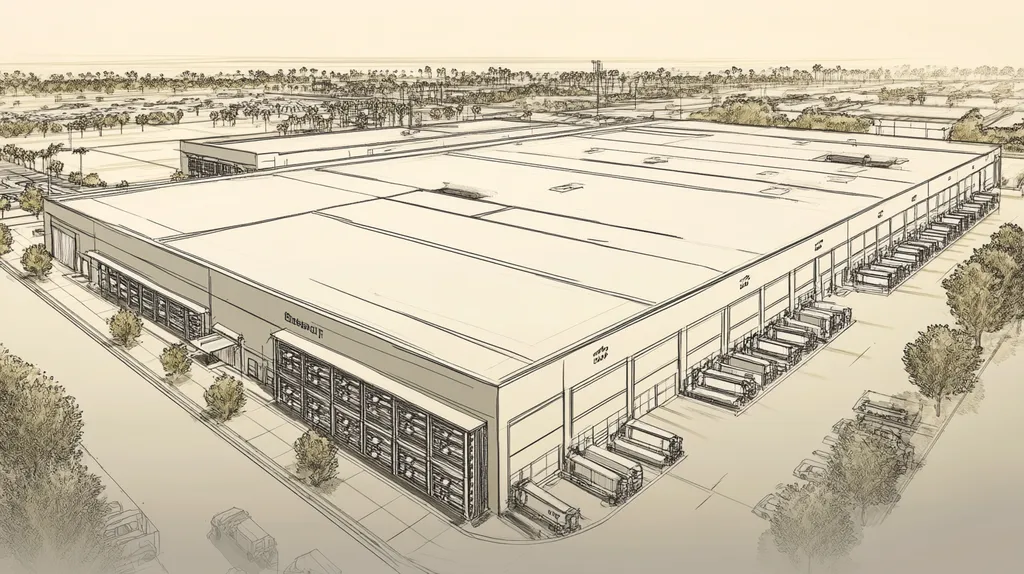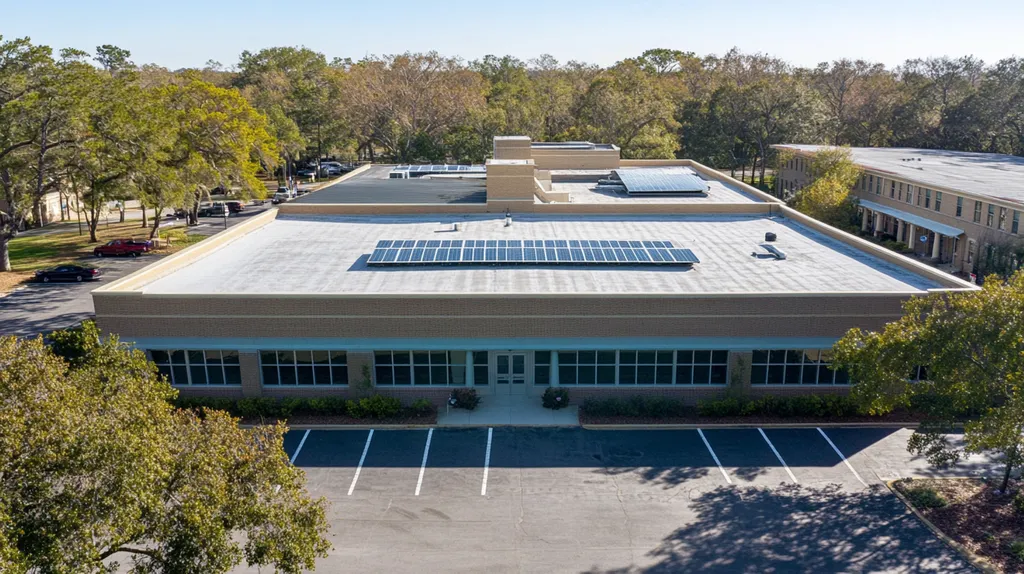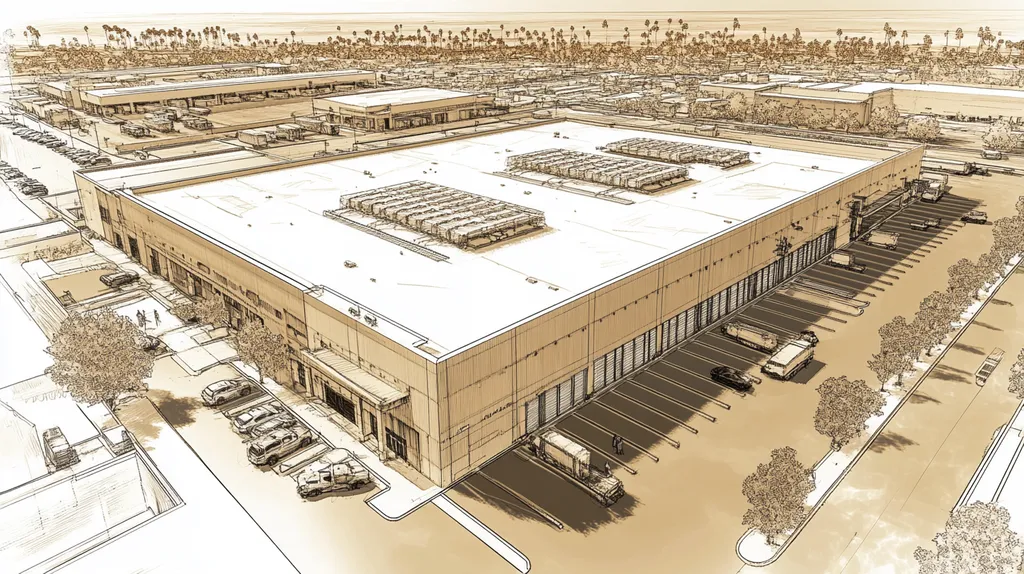For commercial property owners, the lifespan of roof coatings represents a critical factor that can mean the difference between a 10-year and a 25-year roof life expectancy. With coating failures accounting for over 80% of premature roof replacements, understanding durability factors has never been more crucial.
From material selection to application methods, numerous variables influence how long a protective coating will safeguard your investment. Rising material costs and labor shortages have made coating decisions increasingly consequential for facility budgets.
This comprehensive guide examines the key factors affecting coating longevity and provides actionable insights for maximizing roof durability through proper coating selection and maintenance.
SECTION 1: THE BASICS EXPLAINED
Grasping the average lifespan of coatings on commercial roofs is essential for effective building maintenance and financial planning. With roofing costs on the rise, property owners are faced with critical choices that can influence both budgets and the structural integrity of their buildings. The right coating could extend a roof’s life significantly—from just 10 years to 25 years or even longer. This section will demystify what roof coatings are, why they matter for your building, and how they protect your assets.
What It Is (In Plain Language)
Coatings for commercial roofs are specialized materials that enhance durability and weather resistance when applied to the roof surface. They serve as a protective layer, shielding the underlying roofing material from harmful UV rays, moisture, and temperature extremes. Common types of coatings include silicone, acrylic, and polyurea. Each type offers unique benefits based on the environment it’s used in.
These coatings can be easily applied to various roof types, such as metal, asphalt, and single-ply membranes. By creating a seamless surface, coatings help to prevent leaks that can result in significant structural damage over time. Understanding these fundamentals is crucial for property owners looking to make informed roofing decisions.
The right coating not only enhances longevity but also boosts energy efficiency. Reflective coatings can dramatically decrease heat absorption, contributing to lower cooling costs for commercial buildings. This makes coatings a savvy investment, especially for facilities situated in hot climates.
Why It Matters (To Your Building)
The lifespan of roof coatings plays a pivotal role in a building’s overall health. Coatings protect the roof system from harsh weather, thereby minimizing the risk of leaks and structural damage. A well-maintained roof coating can save property owners money by cutting down on maintenance expenses and prolonging the interval between major repairs.
Investing in high-quality coatings can also elevate a property’s resale value. A building with a well-kept roof demonstrates durability and reliability—traits that potential buyers actively seek. Failing to maintain roof coatings can lead to substantial financial losses and negatively affect the building’s utility.
Additionally, compromised or deteriorated roof coatings can create safety hazards. Leaks can lead to workplace dangers, and the repercussions of poor coating longevity go beyond immediate costs; they can impact the overall efficiency of business operations.
How It Works
The effectiveness of roof coatings is rooted in their formulation and application technique. Coatings achieve their protective function by chemically bonding with the substrate, resulting in a robust barrier that withstands various environmental challenges. During application, the coating adheres to the roof surface, filling in minor cracks and imperfections.
Once cured, the coating forms a flexible membrane that accommodates the roof’s expansion and contraction caused by temperature shifts. This flexibility is critical for preventing cracks or peeling, which could jeopardize the roof’s integrity. Some coatings also contain reflective particles that help deflect sunlight, further shielding the roof from heat damage.
Proper installation and routine maintenance are vital for maximizing the lifespan of any coating. Property owners should schedule regular inspections and apply additional coats as needed. This proactive strategy allows for early detection of potential issues before they escalate into costly repairs.
SECTION 2: PRACTICAL APPLICATIONS
Understanding the average lifespan of coatings on commercial roofs is vital for property owners and facility managers. Roof coatings act as crucial shields against the elements, and when they wear down, the consequences can be costly. For instance, a disregarded roof can suffer from moisture intrusion, leading to extensive structural damage. This section explores common applications for roof coatings, the best times to apply them, and their interactions with other roofing systems.
Common Uses & Examples
Roof coatings are versatile tools used in various commercial settings, all aimed at boosting durability. For example, elastomeric coatings work wonders in areas with intense UV exposure. They reflect sunlight and help keep cooling costs down. Reflective coatings are particularly beneficial on flat roofs, reducing interior temperatures and enhancing energy efficiency.
Re-coating metal roofs is another excellent use of coatings, significantly extending their lifespan. This practice not only protects against rust and corrosion but also improves overall appearance. In settings like industrial warehouses, applying a simple coat can add years to the roof’s life.
Coating systems can also repair existing materials, cutting down the expense typically associated with complete roof replacements. This adaptability allows coatings to cater to a wide range of building types and regional conditions.
By understanding these practical applications, facility managers can make informed decisions that meet their operational needs and remain within budget.
When You Need It Most
The timing of applying roof coatings is crucial to maximizing their effectiveness and lifespan. Specific conditions, such as extreme weather or seasonal shifts, can heighten risks for uncoated roofs. For example, winter moisture or summer heat can rapidly deteriorate roofing materials if left unprotected.
The ideal time to apply coatings is often just before these weather extremes hit. Property owners should consider conducting inspections ahead of storm seasons to ensure that coatings are secure and effective. Regular maintenance checks should aim to assess the condition of existing coatings and address any wear.
Building age also plays an important role in the need for coatings. Older roofs that show signs of wear greatly benefit from timely applications. Ignoring these signals can lead to increased repair costs and disruptions to business operations.
In conclusion, proactive maintenance—especially through timely coating applications—is essential for extending the lifespan of commercial roofs.
Interactions With Other Systems
The performance of roof coatings is linked to their interactions with other roofing systems and components. For instance, the insulation underneath the coatings must be compatible to ensure thermal efficiency. Incompatible materials can lead to moisture issues, compromising both the insulation and coating functionalities.
Moreover, coatings need to work harmoniously with drainage systems to manage water runoff effectively. Ensuring that drains are clear and functional before coat application can prevent water pooling, which could result in coating failure and structural problems.
Additionally, selecting the right roofing materials to use beneath the coatings is crucial. Some coatings perform best with single-ply membranes, while others are designed for compatibility with metal or bitumen roofs. This consideration is vital for achieving optimal performance and longevity.
By understanding these interactions, facility managers can craft a comprehensive roofing maintenance strategy. This approach not only preserves the integrity of the roof but also maximizes the advantages of protective coatings.
SECTION 3: KEY TERMINOLOGY DECODED
Understanding the jargon that surrounds roofing is crucial for making informed decisions. Many property owners and facility managers underestimate the significance of specific terms, leading to potentially costly misunderstandings down the line. For example, knowing the differences between coating types can significantly affect both the lifespan and performance of a roof. This section aims to clarify essential terminology, demystify industry jargon, and break down measurements, empowering stakeholders to approach roofing projects with greater confidence.
Essential Terms Explained
Several key terms influence both the durability and maintenance of commercial roofs. “Roof Coating” is a protective layer that’s applied to the roof’s surface to enhance its longevity. This layer plays a vital role in improving the roof’s resistance to damaging UV rays and moisture.
Another important term is “Reflectivity,” which measures a coating’s ability to bounce back sunlight. High reflectivity levels can lead to lower cooling costs, making this an essential factor for energy-efficient roofing solutions.
“Elasticity” is yet another crucial term, defined as a coating’s ability to stretch and revert to its original shape. This property is vital for accommodating temperature fluctuations, which can significantly extend the lifespan of a roof.
Grasping these terms allows property owners to make informed choices about materials that fit their facilities’ needs and budgets. Using accurate terminology can also lead to more productive discussions with contractors.
Industry Jargon Translated
The technical language of the roofing industry can often seem daunting, but understanding it is key. For instance, “Total Solar Reflectance” (TSR) is a critical metric indicating how much solar energy a coating can reflect. A higher TSR means lower cooling costs for commercial buildings during hot summer months.
Another term that frequently causes confusion is “Service Life.” This refers to the expected duration that a coating will perform effectively under normal conditions. Misestimating the service life can lead to unplanned replacements and budget issues.
Warranties also contain important jargon. For instance, a “Full System Warranty” covers not only the roofing coating but also all components and labor. This warranty provides crucial financial protection for property owners.
By breaking down this jargon, stakeholders can communicate more effectively with contractors and suppliers, ensuring that roofing projects are completed successfully and meet all expectations.
Measurement & Units Simplified
Understanding measurements is vital for evaluating roof coatings. The term “mils” refers to the thickness of a coating, with thicker applications often offering better protection—though at a higher material cost.
Another key term is “SPF,” which stands for “Square Feet Per Gallon.” This metric indicates how much area one gallon of coating will cover. Knowing the SPF helps facility managers determine how much product they need for their specific roofing projects.
It’s also important to consider “VOCs,” or volatile organic compounds, as these indicate the environmental impact of coatings. Opting for low-VOC products can help meet regulatory requirements and support sustainability initiatives.
By simplifying these measurements, property owners and facility managers can make informed decisions about their coating projects, ensuring effective budgeting and better resource management.
SECTION 4: DECISION FACTORS
Choosing the right roofing coating is essential for safeguarding commercial roofs and ensuring their longevity. Property managers face significant risks when making these decisions, as the average coating lifespan can fluctuate between 5 to 15 years. This variation can lead to unexpected maintenance costs and even premature failures if coatings are not suited for the building’s needs. By understanding key factors—cost considerations, performance trade-offs, and lifespan factors—property owners can make informed choices that protect their investments.
Cost Considerations
When evaluating roofing coatings, cost often takes center stage. While low initial prices may be appealing, they can result in higher expenditures in the long run. For instance, a budget-friendly coating might require replacement sooner than a high-quality alternative, negating any initial savings.
It’s crucial to look beyond the upfront costs and consider the overall financial impact. A robust coating can save thousands by reducing labor and materials needed for frequent replacements. Additionally, energy-efficient coatings can lower utility bills, providing even more savings over time.
The budget can also affect material choices and application methods. While advanced materials usually require a greater initial investment, their longevity and performance can justify the expense. Facility managers are encouraged to conduct a total cost of ownership analysis to understand the long-term benefits of various options.
Performance Trade-offs
Selecting a roofing coating means weighing various performance trade-offs. Some coatings may excel in UV protection but might sacrifice flexibility or adhesion. Achieving the right balance is crucial for achieving durability and efficacy.
Property owners must also assess environmental factors such as climate and building exposure. Reflective coatings, for example, can greatly reduce cooling costs in hot climates but may not perform as well in colder, wetter conditions.
Another important consideration is the thickness of the coating. Thicker coatings typically provide enhanced protection, but they can also incur higher costs and present application challenges. Every property is unique, and decisions should be tailored to individual circumstances.
Lifespan & Durability Factors
The lifespan of a roofing coating is influenced by several durability factors. Generally, higher-quality materials outperform their less expensive counterparts. For example, silicone coatings often last longer than acrylic ones under certain conditions.
Quality of installation is equally important; poorly applied coatings can fail prematurely, resulting in costly repairs. Therefore, it’s advisable to engage contractors who specialize in specific products to ensure optimal application and performance.
Environmental considerations play a vital role as well. Roofs located in high-traffic areas or subjected to severe weather can experience accelerated wear. Regular inspections and proactive maintenance are key strategies for extending coating lifespan.
Focusing on these durability factors will help property managers make informed decisions that enhance the longevity of their roofs while minimizing both disruptions and costs over time.
SECTION 5: COMMON CHALLENGES
The durability of commercial roof coatings frequently encounters challenges that can significantly shorten their lifespan. Property owners and facility managers need to recognize these issues to prevent expensive repairs and extend the life of their roofs. For example, improper application techniques can diminish the lifespan of coatings by over 50%. This section will explore common challenges, key warning signs to monitor, and effective preventative strategies to maintain optimal roof performance.
Frequent Problems & Solutions
One of the most common problems with roof coatings is inadequate surface preparation. If the surface has dirt, grease, or moisture, the coating may not adhere properly. The solution is straightforward: ensure the surface is thoroughly cleaned and dried before application. Hiring professionals equipped with the right tools can make this process more effective.
Choosing the right coating material is another critical issue. Low-quality products can deteriorate rapidly when exposed to UV rays. To combat this, property owners should select high-grade coatings from reputable manufacturers, ensuring greater durability and performance. A little research can save significant costs in replacements down the line.
Temperature extremes can also create problems like cracking and peeling. Coatings applied during inappropriate weather conditions may fail to cure correctly. Monitoring local weather forecasts and scheduling applications during suitable conditions can enhance the effectiveness of the coatings.
Warning Signs To Watch For
Identifying early warning signs of coating failure is crucial for timely intervention. One major indicator to watch for is any discoloration or fading of the coating surface, which suggests UV damage and may mean it’s time for a re-coat.
Another warning sign is blistering or bubbling, indicating moisture trapped beneath the coating. Tackling these issues promptly can help prevent more significant damage. Regular inspections are vital in catching such problems early.
Ponding water is another concerning sign. Standing water can accelerate deterioration, so it is essential to ensure that drainage systems are functioning properly. Routine maintenance checks can help identify and clear blockages that prevent efficient water runoff.
Preventative Approaches
Proactive maintenance is critical for maximizing the lifespan of commercial roof coatings. Conducting regular inspections allows property owners to spot potential issues before they escalate into costly repairs. Scheduling these checks twice a year helps ensure ongoing evaluation of the roof’s condition.
Applying a protective layer or sealant can significantly enhance durability, acting as a barrier against harmful UV rays and harsh weather conditions. It’s advisable to reapply this layer every few years, depending on the environmental exposure.
Investing in professional training for maintenance staff can also pay off greatly. Educating them on best practices for roof care ensures proper maintenance of coatings, ultimately leading to lower long-term costs. Empowered teams can address issues swiftly, enhancing the roof’s overall longevity.
SECTION 6: NEXT STEPS & RESOURCES
Understanding the lifespan of roofing coatings is crucial for maintaining the longevity of commercial roofs. Delaying proper maintenance can lead to early failures, which may result in significant repair expenses. As a property owner or facility manager, being proactive is key. This section will guide you through essential inquiries for roofing providers, highlight industry standards to consider, and identify resources for continued education.
Questions To Ask Providers
When assessing roofing providers, it’s essential to ask detailed questions about coating systems and their expected lifespans. Inquire about the specific types of coatings they recommend and how they perform under the unique conditions of your building. Understanding warranty specifics is also critical; longer warranties often reflect greater confidence in product durability.
Additionally, ask about the performance testing protocols used for the coatings. Questions regarding UV resistance, temperature tolerance, and weathering can offer insights into how these factors contribute to the coating’s longevity.
Don’t forget to discuss the maintenance requirements after application. Regular upkeep can significantly extend coating lifespan, so understanding what your team will need to do is vital for effective planning and budgeting.
Finally, request references or case studies of similar projects. Past performance can be a strong indicator of a provider’s reliability and the effectiveness of their solutions.
Industry Standards & Guidelines
Getting familiar with industry standards is essential for making informed roofing decisions. The ASTM (American Society for Testing and Materials) publishes guidelines that set performance benchmarks for roofing materials, including coatings. Knowing these standards ensures property managers choose products that meet at least basic durability expectations.
Moreover, guidelines from the National Roofing Contractors Association (NRCA) offer practical insights into best practices for roofing applications and maintenance. These benchmarks help align expectations with industry norms.
Following these standards can establish a proactive maintenance routine that focuses on regular inspections and timely interventions. This approach not only maximizes the lifespan of roof coatings but also helps avoid unexpected repair costs.
Keeping track of these evolving standards improves communication with service providers and helps achieve long-term goals for roof durability.
Further Learning Simplified
Attending industry trade shows and webinars can also expose you to the latest innovations in roofing coatings. Networking with experts at these events often yields practical insights and helpful tips.
Many manufacturers offer training programs that detail their specific products and application techniques. Utilizing these resources can enhance decision-making and improve maintenance practices.
By prioritizing continuous learning, property owners and facility managers ensure they stay informed about products and methods that enhance the lifespan of their roofing systems.
The Bottom Line
With coating failures driving 80% of premature roof replacements and average repair costs exceeding $15,000, understanding coating lifespan factors has never been more critical for facility managers.
Proper coating selection, professional application, and regular maintenance can extend a commercial roof’s service life from 10 years to 25 years or beyond.
Environmental stressors, material quality, and installation expertise all play vital roles in determining coating durability.
By following industry standards, implementing preventative maintenance programs, and staying informed about coating innovations, property owners can maximize their roofing investments while avoiding costly failures.
The future of commercial roofing depends on making informed decisions today about coating systems that will protect facilities for decades to come.
FREQUENTLY ASKED QUESTIONS
Q. What is the average lifespan of coatings on a commercial roof?
A. The average lifespan of coatings can range from 10 to 25 years, depending on the type and application. Factors like weather exposure, material quality, and maintenance practices greatly influence longevity. Investing in quality coatings can lead to significant savings and improved roof performance.
Q. When is the best time to apply coatings on an industrial roof?
A. The ideal time for application is just before extreme weather changes, like summer heat or winter moisture. Regular inspections can help catch wear, allowing you to apply coatings at the right moment. Taking action at these key times can maximize the lifespan and effectiveness of the coatings.
Q. What key terms should I know about commercial roof coatings?
A. Understanding terms like “reflectivity,” “elasticity,” and “service life” is critical. Reflectivity indicates how much sunlight a coating can bounce back, lowering cooling costs. Elasticity measures how the coating stretches and returns to its shape, essential for adapting to temperature changes.
Q. How do I choose the right coating for my commercial roof?
A. Selecting a coating involves considering factors like cost, performance, and environment. While cheaper options may lure you in, quality products often deliver better long-term benefits. Assess your building’s unique needs and consult with professionals to find the best solutions for your situation.
Q. What common challenges affect the lifespan of commercial roof coatings?
A. Frequent challenges include poor surface preparation, inadequate material choice, and extreme temperatures. Neglecting these factors can lead to early failures and costly repairs. Ensuring thorough cleaning and selecting high-quality materials are vital steps in maintaining your coatings.
Q. What questions should I ask when hiring a roofing provider for my commercial roof?
A. Inquire about the recommended coating types, warranty details, and maintenance needs. Understanding their performance testing protocols and getting references from past projects can provide valuable insights. These questions help ensure you are making informed choices when selecting a roofing provider.
Q. How can I educate myself further on roof coating technologies?
A. Access industry publications online, attend trade shows, and participate in webinars to learn more. Engaging with experts and leveraging manufacturer training can enhance your knowledge about specific products. Continuous education empowers you to make better decisions for your maintenance strategy.










